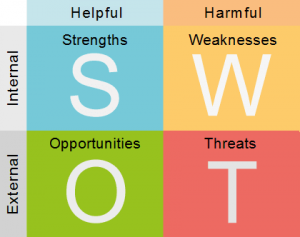
Understanding the Agile SWOT Analysis: Enhancing Project Insight
The SWOT analysis is a widely employed strategic tool that offers an effective perspective on strengths, weaknesses, opportunities, and threats related to the subject under consideration.
SWOT stands for Strengths, Weaknesses, Opportunities, and Threats.
The Agile SWOT in Action
The Agile SWOT analysis can be applied in two compelling contexts:
- As a retrospective session tool
- For product analysis
Let’s delve into these distinct contexts.
In Retrospective Sessions
The retrospective, a pivotal meeting in Agile, particularly Scrum, demands dynamic content in each session. This is where the SWOT analysis can come into play for a single session.
Engaging the development team in identifying strengths, weaknesses, opportunities, and threats related to the concluding sprint(s) can yield valuable insights.
Some examples include:
- Strength: Positive team atmosphere, engaging projects
- Weakness: Disruptive bugs and technical issues slowing progress
- Threat: Escalating disruptions, lack of unit tests
- Opportunity: Implement unit tests, introduce code review
Utilizing SWOT aids the development team in jointly assessing the sprint context. The Scrum Master can then identify areas for improvement and address them collaboratively.
At the session’s close, it’s valuable to encourage developers to pinpoint main areas of improvement collectively. This approach fosters a united team with a shared vision.
Once primary improvement areas are identified, displaying them on the office wall ensures ongoing awareness and focus on improvements.
In Product Improvement Sessions
The SWOT analysis is equally potent for enhancing products. In a startup-sized company, convening all employees around a board or large table for a SWOT session can be fruitful.
This exercise is effective due to the varied perspectives of departments like marketing and customer service. While marketing may have some distance from customers, customer service interacts with them regularly.
Through the SWOT analysis, a common vision emerges, and previously unknown issues can be uncovered. The collective strength gained from this practice is significant.
In larger groups, a subset of participants may need to be selected due to size constraints.
At the session’s conclusion, a report can be compiled and shared with participants, disseminating the insights captured in the SWOT analysis.
The Agile SWOT Matrix
Below is a representation of the SWOT matrix:

As evident, the matrix comprises four segments. This visual arrangement can be engaging when displayed on a wall or table. Using sticky notes, participants can contribute their insights.
Each individual can place a sticky note in the relevant SWOT quadrant and express their observations. For instance, if someone identifies that “the product is outdated,” they can jot it down on a sticky note and place it in the weakness or threat quadrant.
For larger groups, the board might be filled with numerous sticky notes.
Upon placing all sticky notes, it’s often beneficial to collaboratively rate each note. A useful rating system ranges from 1 (least important) to 10 (most important). The facilitator should exercise caution, as this step can be




1 Trackback / Pingback